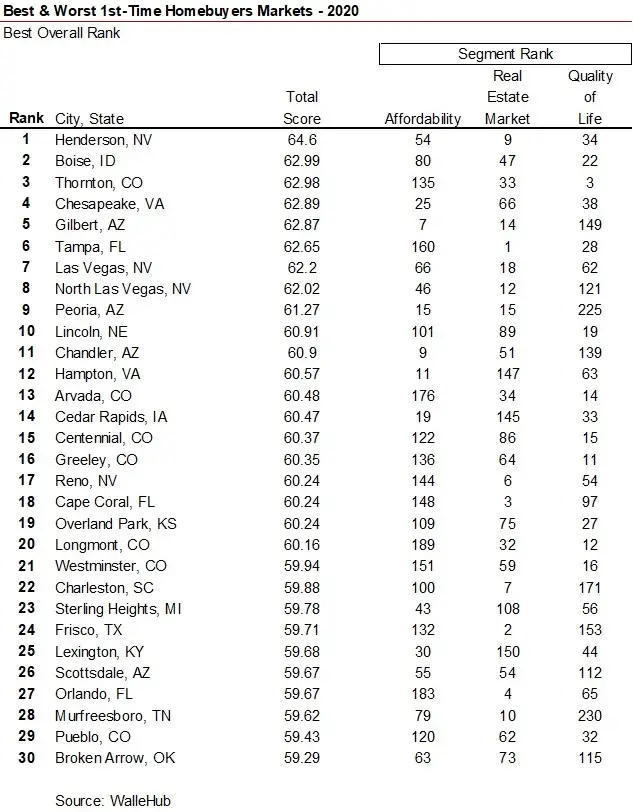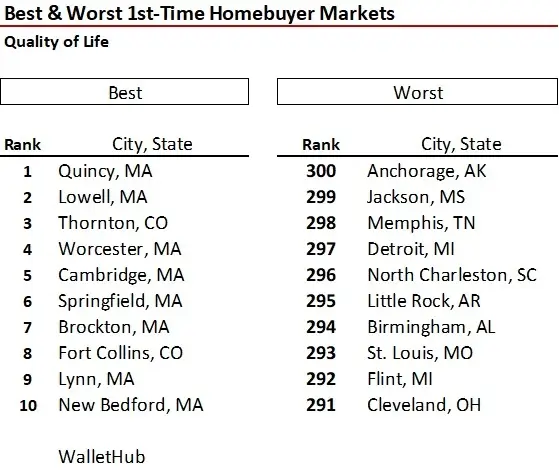Another Top-10 (Percent) List -- Best (and Worst) Cities for 1st-Time Homebuyers
The home remains the largest store of wealth for most households. Homebuying is a complicated process – particularly for unfamiliar first-time buyers. Still, first-time homebuyers represented one-in-three of all home sales (33 percent) according to the National Association of Realtor’s latest Annual Profile of Home Buyers and Sellers.
Some cities offer better opportunities than others for first-time buyers based on a myriad of factors. WalletHub.com examined data from the largest 300 cities in the country (where data were available) focusing on three primary sets of factors: Affordability, Real Estate Market, and Quality of Life. Within these three factors, 26 metrics were graded using a score where 100 represented the most favorable conditions for first-time homebuyers and zero the worst. The metrics along with respective weights employed are listed as follows. Data flagged with an asterisk * are at the statewide level only.
Affordability 33.3 Points
Housing Affordability 14.28 points
Average Cost of Homeowner’s Insurance * 4.76 points
Cost of Living 4.76 points
Cost per Square Foot 4.76 points
Real Estate Tax 4.76 points
Real Estate Market 33.3 points
Rent-to-Price Ration 4.44 points
Housing Market Health Index 2.22 points
Percent of Homes Sold in One Year 2.22 points
Median Home Price Appreciation 4.44 points
Percent of Mortgage Holders with Negative Equity 2.22 points
Buy vs Rent Breakeven Horizon 2.22 points
Percent of Listings with Price Cuts 2.22 points
Percent of Housing Units Built from 2010 to 2018 2.22 points
Building Permit Activity 2.22 points
Mortgage Lenders per Capita 2.22 points
Real Estate Agents per Capita 2.22 points
Millennial Homeownership Rate 2.22 points
Quality of Life 33.3 points
Coronavirus Support Score * 9.09 points based on Wallethub’s States Offering the Most Coronavirus Support Score
Weather 3.03 points
School System Quality * 3.03 points
Driver-Friendliness 3.03 points
Job Market 3.03 points
Total Home Energy Costs 3.03 points
Violent Crime Rate 3.03 points
Property Crime Rate 3.03 points
The cities are the individually incorporated locales and are subcomponents of larger Metropolitan Statistical Areas (MSAs). As an example, a few of the member cities of the San Francisco-Oakland-Hayward MSA include San Francisco (which ranked 299th overall), Oakland (295th), and Daly City (293rd). The first table shows the top-10 percent (best 30 of the 300 analyzed). Henderson, Nevada tops the list overall, and is a component of the Las Vegas-Henderson-Paradise MSA. Other member cities in the top-10 percent of best cities for 1st-time homebuyers include Las Vegas (7th overall), North Las Vegas (9th).

The next table listed the bottom overall-ranked 30 cities (10-percent). California cities dominate the bottom rankings, making up 19 of the worst 30-ranked cities.
The next table shows the 10-best and worst-ranked cities with respect to Affordability. All but two of the bottom 10-rankings based on affordability are located in California.

Rankings based on Local Real Estate Markets are shown next. New Jersey and New York each placed three locales in the bottom 10-city group based on local real estate markets.

The 10-best and 10-worst cities based on Quality of Life are shown in the next table. Eight of the 10-best cities for Quality of Life for 1st-time homebuyers are from Massachusetts. This was skewed by the Coronavirus Support Score metric which is statewide. Details on that study can be found at https://wallethub.com/edu/states-offering-the-most-coronavirus-support/73333/

Click here for a complete listing of all 300 ranks. To read the entire WalletHub study click https://wallethub.com/edu/best-and-worst-cities-for-first-time-home-buyers/5564/
Selection of included metrics and weightings both influence the outcome of these rankings. A material 9.1 percent of the total overall weight is assigned to the Coronavirus Support Score Metrics, three times that each of Violent Crime , Total Home Energy Costs or the Local Jobs Market. That metric skewed the results in favor of states with robust Coronavirus help and against those without. Changing the metrics and weightings will alter the outcome.
Despite headwinds from these factors, record-low interest rates are a rising-tide positive for all homebuyers – repeat and first-timers. Even better news is the latest forecast from Fannie Mae expecting 30-year fixed-rate, conventional mortgage interest rates to drop from an average 3.1 percent in 2020 to 2.7 percent average in 2021. Low rates are helping housing sustain the economic recovery from the pandemic.
Ted
